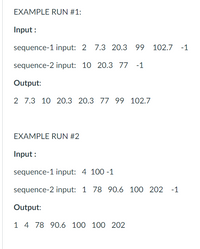
Database System Concepts
7th Edition
ISBN: 9780078022159
Author: Abraham Silberschatz Professor, Henry F. Korth, S. Sudarshan
Publisher: McGraw-Hill Education
expand_more
expand_more
format_list_bulleted
Concept explainers
Question
DO THIS USING 4 WHILE LOOPS!
no language of "break", "true" please

Transcribed Image Text:HW #5: Merging Sorted Lists
DUE Wednesday 3/2 at 12:44pm
As input, enter two non-negative number sequences in increasing order (the numbers entered are always getting bigger, and no
number repeats), both terminated by a -1. The size of each sequence can vary (maybe sequence-1 has four numbers, and
sequence-2 has seven).
You code needs to then output a third sequence that is a combination of sequence 1 and sequence 2, and is sorted in non-
decreasing order.
How is non-decreasing order different from increasing order?
This means there can be a repeated number in the third sequence (see Example runs 1&2 for examples of output with a
repeated number). A strictly increasing order sequence cannot have repeat numbers at all (Example runs 3 & 4 have output that
is in increasing order). Remember, all input sequences must be in strictly increasing order!
HINT: use three separate lists to solve this!

Transcribed Image Text:EXAMPLE RUN #1:
Input :
sequence-1 input: 2 7.3 20.3 99 102.7 -1
sequence-2 input: 10 20.3 77
-1
Output:
2 7.3 10 20.3 20.3 77 99 102.7
EXAMPLE RUN #2
Input :
sequence-1 input: 4 100 -1
sequence-2 input: 1 78 90.6 100 202 -1
Output:
1 4 78 90.6 100 100 202
Expert Solution
This question has been solved!
Explore an expertly crafted, step-by-step solution for a thorough understanding of key concepts.
Step by stepSolved in 2 steps with 1 images

Knowledge Booster
Learn more about
Need a deep-dive on the concept behind this application? Look no further. Learn more about this topic, computer-science and related others by exploring similar questions and additional content below.Similar questions
- Positive loops have a tendency to reinforce the original action. O True Falsearrow_forwardIs there a way for a programmer to recognize an infinite loop and break out of it?arrow_forwardPlease help me with this question in python using psedocode details. I have attached both pictures below:-arrow_forward
arrow_back_ios
arrow_forward_ios
Recommended textbooks for you
 Database System ConceptsComputer ScienceISBN:9780078022159Author:Abraham Silberschatz Professor, Henry F. Korth, S. SudarshanPublisher:McGraw-Hill Education
Database System ConceptsComputer ScienceISBN:9780078022159Author:Abraham Silberschatz Professor, Henry F. Korth, S. SudarshanPublisher:McGraw-Hill Education Starting Out with Python (4th Edition)Computer ScienceISBN:9780134444321Author:Tony GaddisPublisher:PEARSON
Starting Out with Python (4th Edition)Computer ScienceISBN:9780134444321Author:Tony GaddisPublisher:PEARSON Digital Fundamentals (11th Edition)Computer ScienceISBN:9780132737968Author:Thomas L. FloydPublisher:PEARSON
Digital Fundamentals (11th Edition)Computer ScienceISBN:9780132737968Author:Thomas L. FloydPublisher:PEARSON C How to Program (8th Edition)Computer ScienceISBN:9780133976892Author:Paul J. Deitel, Harvey DeitelPublisher:PEARSON
C How to Program (8th Edition)Computer ScienceISBN:9780133976892Author:Paul J. Deitel, Harvey DeitelPublisher:PEARSON Database Systems: Design, Implementation, & Manag...Computer ScienceISBN:9781337627900Author:Carlos Coronel, Steven MorrisPublisher:Cengage Learning
Database Systems: Design, Implementation, & Manag...Computer ScienceISBN:9781337627900Author:Carlos Coronel, Steven MorrisPublisher:Cengage Learning Programmable Logic ControllersComputer ScienceISBN:9780073373843Author:Frank D. PetruzellaPublisher:McGraw-Hill Education
Programmable Logic ControllersComputer ScienceISBN:9780073373843Author:Frank D. PetruzellaPublisher:McGraw-Hill Education

Database System Concepts
Computer Science
ISBN:9780078022159
Author:Abraham Silberschatz Professor, Henry F. Korth, S. Sudarshan
Publisher:McGraw-Hill Education

Starting Out with Python (4th Edition)
Computer Science
ISBN:9780134444321
Author:Tony Gaddis
Publisher:PEARSON

Digital Fundamentals (11th Edition)
Computer Science
ISBN:9780132737968
Author:Thomas L. Floyd
Publisher:PEARSON

C How to Program (8th Edition)
Computer Science
ISBN:9780133976892
Author:Paul J. Deitel, Harvey Deitel
Publisher:PEARSON

Database Systems: Design, Implementation, & Manag...
Computer Science
ISBN:9781337627900
Author:Carlos Coronel, Steven Morris
Publisher:Cengage Learning

Programmable Logic Controllers
Computer Science
ISBN:9780073373843
Author:Frank D. Petruzella
Publisher:McGraw-Hill Education